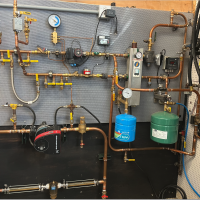New thermostatic radiator valve on old radiator fitting?
Hello again after a long absence. I have a roughly 100 year old radiator valve that is seized and I would like to replace it with a thermostatic valve. The existing fittings are all 3/4". The system is pumped hot water. Pic is attached.
A few questions:
- I have easy access to Danfoss and Honeywell TRVs. Any opinions on which is better? I'm also willing to shop elsewhere if there are better options.
- I've read that for my type of installation it's better to have the thermostatic actuator body project horizontally (to the left of the valve body for my rad) rather than vertically above the valve body, because heat from the supply pipe will rise up into a vertical thermostat and create a false reading. I'd prefer vertical in order to save space to the left of the rad. Will this be an issue?
- Any chance the union fitting on the new valve will mate with the existing 100 year old union fitting and not leak? I'm prepared to remove the old union fitting if needed, but the last time I did that I needed to carefully cut the old fitting out from the bushing, and I'd rather not do that again.
- Any thoughts on how long TRVs usually last before the actuator body or other parts need replacing? Part of me thinks it might be easier to just use a conventional valve and control things manually, with the hope that a conventional valve will last many decades.
TIA!
Comments
-
-
Whatever you replace it with you will have to replace the spud and union fitting. A new valve will probabl last longer than a TRV. If a TRV goes bad it is usually the actuator and the valve is ok.
You have to position the actuator the way the mfg instructions show or use a remote sensor.
TRVS and radiator valves are not all the same dimensions so shop wisely.
Honeywell, Danfoss Tunstall associates sells Macon they are all about the same. Pick the one that fits physically the best.
1 -
-
This actuator: Honeywell T104B 1038
This valve: Honeywell V110E 1012
You can place the temperature sensor up to 6 feet away from the radiator. However, you will have an exposed capillary tube from the control the the actuator. and the short valve profile you want to use.
Edward Young Retired
After you make that expensive repair and you still have the same problem, What will you check next?
0 -
there are ways that a TRV can send a heat call
The TRV starts to open in a call for heat
A delta P circulator wakes up and starts circulation
A current sensing relays on the circ closes a contact to fire a boiler or whatever supplies the hot water
TRV are very simple inside. A thermal capsule just like mixing valves or the thermostat in you truck modulates based on temperature
In clean fluid they are trouble free and last a long time
Bob "hot rod" Rohr
trainer for Caleffi NA
Living the hydronic dream0 -
Yes, a delta P circ and a current sensing relay would allow the TRV to initiate a call for heat - if that radiator were the only one being fed from that circulator. But if not, then how would you regulate the heat in the rest of the house since the circulator would “see” the open pathway through the rest of the radiators and run continuously?
Bob Boan
You can choose to do what you want, but you cannot choose the consequences.0 -
Which is why, if one is planning to use TRVs on a hydronic system, the best arrangement — perhaps the only one which is going to do what one really wants — is outdoor reset controlling constant circulation (delta P) (the secondary circulator(s) are never turned off) water at whatever temperature is needed for the full design load at that outdoor temperature. (OR controls a mixing valve, primary/secondary piping)
And it should be all or nothing — at the v3ry least, individual small zones under local control preferably individual rooms or even radiation.
Br. Jamie, osb
Building superintendent/caretaker, 7200 sq. ft. historic house museum with dependencies in New England0 -
I experienced one customer where I installed TRVs on several radiators so the tenants would stop leaving the window open because of excessive heat and the fuel usage went from over 4000 gallons per year down to less than 2000 gallons per year.
Rooming house in Cape May NJ
- install four TRVs on the hottest rooms
- install thermostat in owner's apartment
- install remote sensor on owner's thermostat with the sensor in the coldest room
Result was to cut fuel usage from 4000 gallons to 2500 gallons
Next summer,
- install 7 more TRVs in the remainder of the building
- Install ∆P circulator
Reduce fuel usage to 1900 gallons per year
Net result: The coldest room is always open full, the thermostat will call for heat and keep that room comfy. All the other rooms and the owner's apartment will be adjustable to each individual's comfort. …and Very happy customer, + Unhappy fuel dealer = Had to buy dinner for the fuel dealer and his wife to tell them "at least they didn't switch to gas heat!"
Edward Young Retired
After you make that expensive repair and you still have the same problem, What will you check next?
0 -
Interesting discussion about secondary circulators and about wiring the TRV to give it the ability to call for heat.
I think my situation is a bit simpler though. The room it will be in always tends to be on the warm side when the heat is on, and since the existing valve is seized I can't adjust it. The objective is to allow us to dial the flow back in order to balance the room temp with the rest of the house. That's why I'm also considering just installing a simple/traditional hot water radiator valve. I'd hopefully be able to just crack the valve open a small amount and find a sweet spot in terms of room temperature.
0 -
That is all the owner of the rooming house in Cape May wanted. four new hand operated valves. I talked her into the TRV's for about $400.00 more. The labor to drain the system, replace the valves and fill and vent the system was the same for both jobs, and the result with the lower cost job would be to manually enter the tenants room and adjust the valve by hand and see how that worked, then back again a few hours later to see how that adjustment worked, then back the next day to see how the room temperature is doing now…. and on, and on, and on!
TRV = tell the tenant if the room gets too hot turn the dial to the left. If the room gets too cold turn the dial to the right. Let the tenant select the comfort level and the valve will do the work for you.
In the Cape May "coldest room" I played a psychology trick on that occupant. I placed the remote sensor behind a T8222D thermostat and let them adjust the thermostat as needed. The thermostat was not wired to anything. It just hid the remote sensor.
Edward Young Retired
After you make that expensive repair and you still have the same problem, What will you check next?
0 -
Ed, That makes a lot of sense. It's great that the fuel savings were so significant.
Thankfully, it's just me and my better half, and we can access the room any time.
0 -
You have a point there, but do you want to have to access the room any time or should I say ALL the time. The point of the TRV is that it is automatic. So the labor to install a manual valve or a TRV is identical for you. the only cost difference is the price of the valve and actuator. I like the idea of the remote actuator with the 6 foot capillary tube where you have confined space for the valve to be installed.
Edward Young Retired
After you make that expensive repair and you still have the same problem, What will you check next?
1
Categories
- All Categories
- 87.3K THE MAIN WALL
- 3.2K A-C, Heat Pumps & Refrigeration
- 61 Biomass
- 427 Carbon Monoxide Awareness
- 119 Chimneys & Flues
- 2.1K Domestic Hot Water
- 5.8K Gas Heating
- 114 Geothermal
- 165 Indoor-Air Quality
- 3.7K Oil Heating
- 76 Pipe Deterioration
- 1K Plumbing
- 6.5K Radiant Heating
- 395 Solar
- 15.6K Strictly Steam
- 3.4K Thermostats and Controls
- 56 Water Quality
- 51 Industry Classes
- 50 Job Opportunities
- 18 Recall Announcements




